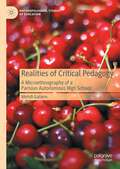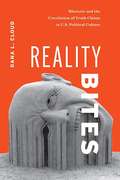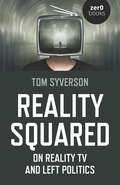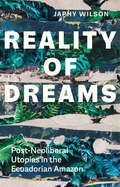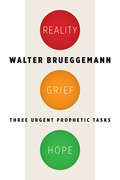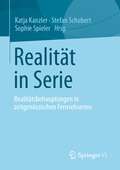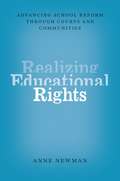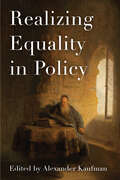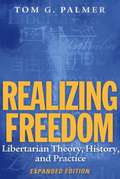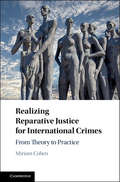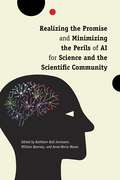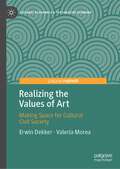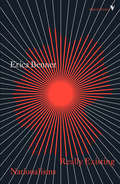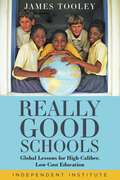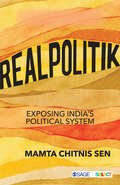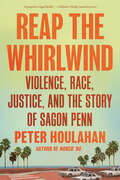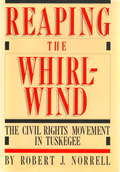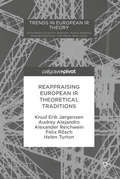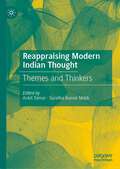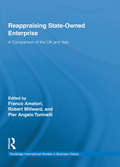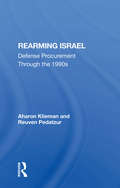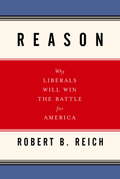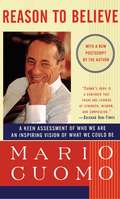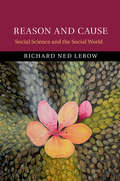- Table View
- List View
Realities of Critical Pedagogy: A Microethnography of a Parisian Autonomous High School (Anthropological Studies of Education)
by Mehdi GaliereThis book examines how the Lycée autogéré de Paris, an experimental high school established in 1982 which claims to implement critical and democratic pedagogical practices, contributes to the development of counter-hegemonic educational and social practices. The author presents and analyses significant discursive data on the school’s pedagogical practice, focusing specifically on triangulation, from general assemblies to official texts, pedagogic projects and everyday interactions inside and outside the institution. He then argues that the discourses of the self-managed high school tend to be critical of the French state’s neoliberal discourse on education while favouring the development of practices of solidarity within the local and broader context of the institution. The book will be of interest to students and scholars in the fields of sociology of education, sociolinguistics and education for social justice.
Reality Bites: Rhetoric And The Circulation Of Truth Claims In U. S. Political Culture
by Dana L. CloudFake news, alternative facts, post truth--terms all too familiar to anyone in U.S. political culture and concepts at the core of Dana L. Cloud's new book, Reality Bites, which explores truth claims in contemporary political rhetoric in the face of widespread skepticism regarding the utility, ethics, and viability of an empirical standard for political truths. Cloud observes how appeals to truth often assume--mistakenly--that it is a matter of simple representation of facts. However, since neither fact-checking nor "truthiness" can respond meaningfully to this problem, she argues for a rhetorical realism--the idea that communicators can bring knowledge from particular perspectives and experiences into the domain of common sense. <P><P> Through a series of case studies--including the PolitiFact fact-checking project, the Planned Parenthood "selling baby parts" scandal, the Chelsea Manning and Edward Snowden cases, Neil DeGrasse Tyson's Cosmos, the rhetoric of Thomas Paine and the American Revolution, and the Black Lives Matter movement--Cloud advocates for the usefulness of narrative, myth, embodiment, affect, and spectacle in creating accountability in contemporary U.S. political rhetoric. If dominant reality "bites"--in being oppressive and exploitative--it is time, Cloud argues, for those in the reality-based community to "bite back."
Reality Squared: On Reality TV and Left Politics
by Tom SyversonIn this concise but rich book, Syverson refutes the common notion that reality television is superficial or inauthentic, explaining how such criticisms fail to appreciate the way that we form social reality in the first place. By examining shows like The Hills, The Real Housewives, Vanderpump Rules, and The Bachelor alongside postmodern philosophy, feminist theory, and political economy, Syverson argues that we can confront today&’s postmodern condition only by accepting it on its own terms. To what extent does reality television mimic and shape our public and personal lives? Is reality television a dangerous, shallow decadence, or can it provide the key to understanding our postmodern moment? And above all, what does the election of Donald Trump mean for progressive fans of the genre? Reality Squared tackles these questions head-on, arguing that reality television represents the great modern art form, and the only entertainment vehicle capable of showing what it feels like to be alive today.
Reality and Its Dreams
by Raymond GeussOne of political philosophy's most trenchant and inventive critics challenges the field's normative turn, arguing that the study of politics should focus on real politics, where normative judgments arise from concrete configurations of power. Raymond Geuss shows how this can be done without succumbing to a toxic relativism or abandoning utopianism.
Reality of Dreams: Post-Neoliberal Utopias in the Ecuadorian Amazon (Yale Agrarian Studies Series)
by Japhy WilsonAn exploration of radical megaprojects in the Ecuadorian Amazon, considering the fate of utopian fantasies under conditions of global capitalism From 2007 to 2017, the &“Citizens&’ Revolution&” launched an ambitious series of post-neoliberal megaprojects in the remote Amazonian region of Ecuador, including an interoceanic transport corridor, a world-leading biotechnology university, and a planned network of two hundred &“Millennium Cities.&” The aim was to liberate the nation from its ecologically catastrophic dependence on Amazonian oil reserves, while transforming its jungle region from a wild neoliberal frontier into a brave new world of &“twenty-first-century socialism.&” This book documents the heroic scale of this endeavor, the surreal extent of its failure, and the paradoxical process through which it ended up reinforcing the economic model that it had been designed to overcome. It explores the phantasmatic and absurd dimensions of the transformation of social reality under conditions of global capitalism, deconstructing the utopian fantasies of the state, and drawing attention to the eruption of insurgent utopias staged by those with nothing left to lose.
Reality, Grief, Hope: Three Urgent Prophetic Tasks
by Walter BrueggemannWalter Brueggemann is one of the most highly regarded Old Testament scholars of our time; talk-show host Krista Tippett has even called him "a kind of theological rock star." In this new book Brueggemann incisively probes our society-in-crisis from the ground up.Pointing out striking correlations between the catastrophe of 9/11 and the destruction of ancient Jerusalem, Brueggemann shows how the prophetic biblical response to that crisis was truth-telling in the face of ideology, grief in the face of denial, and hope in the face of despair. He argues that the same prophetic responses are urgently required from us now if we are to escape the deathliness of denial and despair.Brueggemann’s Reality, Grief, Hope boldly confronts the dominant forces of our time, taking on principalities and powers that vie for our souls, and calls the church to courageous action.
Realität in Serie: Realitätsbehauptungen in zeitgenössischen Fernsehserien
by Katja Kanzler Sophie Spieler Stefan SchubertRealität(streue) ist ein markantes Thema in der Medienkultur des 21. Jahrhunderts, das sich auf widersprüchliche Weise entfaltet: Realness scheint derzeit sowohl eine Krise als auch eine Konjunktur zu erleben. Der vorliegende Band beleuchtet dieses Thema im medialen Kontext der Fernsehserie mit Hilfe von Fallstudien aus interdisziplinären Perspektiven. Im Mittelpunkt stehen dabei die sozialen, kulturellen, politischen und ästhetischen Potenziale von Realitätsbehauptungen und -effekten in seriellen Fernsehformaten.
Realizing Educational Rights: Advancing School Reform through Courts and Communities
by Anne NewmanIn Realizing Educational Rights, Anne Newman examines two educational rights questions that arise at the intersection of political theory, educational policy, and law: What is the place of a right to education in a participatory democracy, and how can we realize this right in the United States? Tracking these questions across both philosophical and pragmatic terrain, she addresses urgent moral and political questions, offering a rare, double-pronged look at educational justice in a democratic society. Newman argues that an adequate K–12 education is the right of all citizens, as a matter of equality, and emphasizes that this right must be shielded from the sway of partisan and majoritarian policy making far more than it currently is. She then examines how educational rights are realized in our current democratic structure, offering two case studies of leading types of rights-based activism: school finance litigation on the state level and the mobilization of citizens through community-based organizations. Bringing these case studies together with rich philosophical analysis, Realizing Educational Rights advances understanding of the relationships among moral and legal rights, education reform, and democratic politics.
Realizing Equality in Policy
by UnknownEconomic and social inequality have become defining features of the world economy in the late twentieth and early twenty-first centuries. While increased inequality has been particularly pronounced in the United States, a similar phenomenon of increasing inequality of incomes and wealth has emerged in the economies of most major western European states. Realizing Equality in Policy brings together leading scholars to address current issues relating to rising inequality as it affects policy in the areas of education, health care, anti-poverty, employment, and economic policy. With contributions from scholars of both luck and relational egalitarianism, the essays reexamine a number of basic assumptions regarding social and economic policy from an egalitarian perspective. They explore gender-based discrimination, international justice, and the possibility for engagement between socialist and left-liberal thought. Rather than focusing on the subtle distinctions that divide egalitarian views, this volume shows that both views have the potential to offer important insights about how differences might be overcome and gaps might be closed. In offering new directions for solving wealth inequality through policy, Realizing Equality in Policy contributes to ongoing conversations in political theory, economic theory, and moral philosophy.
Realizing Freedom: Libertarian Theory, History, and Practice
by Tom G. PalmerWhat is freedom? How is freedom related to justice, law, property, peace, and prosperity? Tom Palmer has spent a lifetime as a scholar, teacher, journalist, and activist asking and answering these questions. Now as an expanded paperback, Realizing Freedom: Libertarian Theory, History, and Practice collects his best writings. Palmer s work ranges from the theory of justice to multiculturalism, democracy and limited government, and globalization, among many other topics. These essays have appeared in scholarly journals and in such newspapers as the New York Times, Wall Street Journal, and London Spectator. His work is accessible to scholars and thoughtful citizens alike. Palmer has smuggled photocopiers and fax machines into the Soviet Union; organized movements against the draft, taxes, censorship, and victimless crime laws; and ceaselessly promoted freedom in the most hostile locations, from communist Europe and China to Iraq to the halls of academe. Whether writing as a scholar, journalist, or activist, Palmer is never boring and always challenging.
Realizing Reparative Justice for International Crimes: From Theory to Practice
by Miriam CohenThis book provides a timely and systematic study of reparations in international criminal justice, going beyond a theoretical analysis of the system established at the International Criminal Court (ICC). It originally engages with recent decisions and filings at the ICC relating to reparation and how the criminal and reparative dimensions of international criminal justice can be reconciled. This book is equally innovative in its extensive treatment of the significant challenges of adjudicating on reparations, and proposing recommendations based on concrete experiences. With recent and imminent decisions from the ICC, and developments in national courts and beyond, Miriam Cohen provides a critical analysis of the theory and emerging jurisprudence of reparations for international crimes, their impact on victims and stakeholders.
Realizing the Promise and Minimizing the Perils of AI for Science and the Scientific Community
by Kathleen Hall Jamieson, William Kearney, and Anne-Marie MazzaRecommendations from the scientific community to ensure that the development and use of AI honors scientific normsIn late 2022, OpenAI released ChatGPT, an AI chatbot capable of generating conversational answers and analyses, as well as images, in response to user questions and prompts. This generative AI is built with computational procedures, such as large language models, that train on vast bodies of human-created and curated data, including huge amounts of scientific literature. Since then, the worry that AI may someday outsmart humans has only grown more widespread.In the past, as society grappled with the implications of new technologies—ranging from nuclear energy to recombinant DNA—the scientific community developed practices designed to increase adherence to the norms that have protected the integrity of each new form of scientific exploration, development, and deployment. In the process, scientists expanded their community’s repertoire of mechanisms designed to advance emerging science and technology while safeguarding the integrity of science and the wellbeing of the nation and its people.This book provides a historical perspective on and an ethical approach to emerging AI technologies; an overview of AI frameworks and principles; and an assessment of AI’s current advances, hurdles, and potential. Experts from the fields of behavioral and social sciences, ethics, biology, physics, chemistry, mathematics, and computer science, as well as leaders in higher education, law, governance, and science publishing and communication, comprise the book’s contributors. Their essays remind us that, even as our understandings of emerging technologies and of their implications evolve, science’s commitment to core norms and values remains steadfast. The volume’s conclusion advocates for following principles of human accountability and responsibility when using artificial intelligence in research, including transparent disclosure and attribution; verification and documentation of AI-generated data and analysis; a focus on ethics and equity; and continuous oversight and public engagement.
Realizing the Values of Art: Making Space for Cultural Civil Society (Cultural Economics & the Creative Economy)
by Erwin Dekker Valeria MoreaThis book provides a novel approach to the understanding and realization of the values of art. It argues that art has often been instrumentalized for state-building, to promote social inclusion of diversity, or for economic purposes such as growth or innovation. To counteract that, the authors study the values that artists and audiences seek to realize in the social practices around the arts. They develop the concept of cultural civil society to analyze how art is practiced and values are realized in creative circles and co-creative communities of spectators. The insights are illustrated with case-studies about hip-hop, Venetian art collectives, dance festivals, science-fiction fandom, and a queer museum. The authors provide a four-stage scheme that illustrates how values are realized in a process of value orientation, imagination, realization, and evaluation.The book relies on an interdisciplinary approach rooted in economics and sociology of the arts, with an appreciation for broader social theories. It integrates these disciplines in a pragmatic approach based on the work of John Dewey and more recent neo-pragmatist work to recover the critical and constructive role that cultural civil society plays in a plural and democratic society. The authors conclude with a new perspective on cultural policy, centered around state neutrality towards the arts and aimed at creating a legal and social framework in which social practices around the arts can flourish and co-exist peacefully.
Really Existing Nationalisms: A Post Communist View from Marx and Engels (Radical Thinkers)
by Erica BennerAn impressive re-examination of the theories of Marx and Engels on nationalismReally Existing Nationalisms challenges the conventional view that Marx and Engels lacked the theoretical resources needed to understand nationalism. It argues that the two thinkers had a much better explanatory grasp of national phenomena than is usually supposed, and that the reasoning behind their policy towards specific national movements was often subtle and sensitive to the ethical issues at stake.Instead of offering an insular 'Marxian' account of nationalism, the book identifies arguments in Marx and Engels' writings that can help us to think more clearly about national identity and conflict today. These arguments are located in a distinctive theory of politics, which enabled the authors to analyse the relations between nationalism and other social movements and to discriminate between democratic, outward-looking national programmes and authoritarian, ethnocentric nationalism. Erica Benner suggest that this approach improves on accounts which stress the `independent' force of nationality over other concerns, and on those that fail to analyse the complex motives of nationalist actors. She concludes by criticising these 'methodological nationalist' assumptions and 'post-nationalist' views about the future role of nationalism, showing how some of Marx and Engels' arguments can yield a better understanding of the national movements that have emerged in the wake of 'really existing socialism'.
Really Good Schools: Global Lessons for High-Caliber, Low-Cost Education
by James TooleyAlmost overnight a virus has brought into question America&’s nearly 200-year-old government-run K-12 school-system—and prompted an urgent search for alternatives. But where should we turn to find them?Enter James Tooley&’s Really Good Schools. A distinguished scholar of education and the world&’s foremost expert on private, low-cost innovative education, Tooley takes readers to some of the world&’s most impoverished communities located in some of the world&’s most dangerous places—including India and such war-torn countries as Sierra Leone, Liberia, and South Sudan. There, in places where education &“experts&” fear to tread, Tooley finds thriving private schools that government, multinational NGOs, and even international charity officials deny exist. Why? Because the very existence of low-cost, high-quality private schools shatters the prevailing myth in the U.S., U.K., and western Europe that, absent government, affordable, high-quality schools for the poor could not exist. But they do. And they are ubiquitous and in high demand. Founded by unheralded, local educational entrepreneurs, these schools are proving that self-organized education is not just possible but flourishing—often enrolling far more students than &“free&” government schools do at prices within reach of even the most impoverished families. In the course of his analysis Tooley asks the key questions: What proportion of poor children is served? How good are the private schools? What are the business models for these schools? And can they be replicated and improved? The evidence is in. In poor urban and rural areas around the world, children in low-cost private schools outperform those in government schools. And the schools do so for a fraction of the per-pupil cost. Ubiquity, affordability, quality, value for money, equity, choice, and sustainability—these are the seven categories by which schooling should be judged, according to Tooley. In every instance, one is forced to conclude that low-cost, non-governmental, entrepreneurial education, as practiced by the poor around the globe, contains the key to their rise to prosperity and leadership positions within their own respective cultures. Alarmed by recent government barriers in education, Americans can now find hope in the triumph—in the face of acute adversity—of these remarkable schools. Because of the pandemic, parents in America and Europe are discovering that the education of their children is indeed possible—and likely far better—without government meddling with rigid seat-time mandates, outdated school calendars, absurd age-driven grade levels, and worse testing regimes. And having experienced the first-fruits of educational freedom, parents will be increasingly open to the possibilities of ever greater educational entrepreneurship and innovation. Thankfully, they have Really Good Schools to show the way.
Realpolitik: Exposing India’s Political System
by Mamta Chitnis SenPolitical parties are more than just an idea or a representation. They are full-fledged organizations of committed grassroot-level workers helping to build the party brick by brick. Many factors come into play in the rise and survival of a political party. In this book, various leaders and party workers from across party lines bring you insight stories about their associations with political parties, their role in electioneering and fundraising, their emotional investment and its toll on their personal and professional lives. Realpolitik: Exposing India’s Political System delves into the structure and hierarchy of political parties, political godfathers and dynasty politics. It examines the career roadmap of political workers, appeasement of marginalized groups for vote bank politics, tackling dissent, the play of power and money, and the setbacks when tall leaders desert the party. A deeply fascinating read for people interested in the Indian political system and a ‘manual’ for those interested in a career in Indian politics.
Reap the Whirlwind: Violence, Race, Justice, and the Story of Sagon Penn
by Peter HoulahanThe bestselling author of Norco &’80 returns with a riveting story of mid-1980s San Diego that placed one young Black man at the center of a whirlwind of crime and punishment that profoundly altered Southern CaliforniaMarch 31, 1985. Two white patrol officers in search of a gang member followed a pickup truck carrying seven young Black men up a dirt driveway in the Encanto neighborhood of Southeastern San Diego. Minutes later, gunshots rang out, and the truck&’s driver, Sagon Penn, fled the scene in an officer&’s patrol car. The incident stunned the city. What followed would change it forever.Penn was an idealist who believed in the power of Buddhist chants to bring about the oneness of humanity. The two police officers were rising stars in one of the most progressive police departments in the country, yet one that had suffered more officers killed in the line of duty than any other. While the facts of the case were never in dispute, what remained unresolved was what, if anything, could justify such a violent confrontation? For over two years, a determined prosecutor and a charismatic defense attorney engaged in a sensational courtroom drama that revolved around matters of mental health, racial biases, and the self-image of a once-sleepy beach town grappling with its transformation into a major metropolitan area. The Sagon Penn incident forever altered how San Diego would respond to incidents involving police and communities of color.Based on court transcripts, personal interviews, and archival police reports, Reap the Whirlwind is a gripping true-crime narrative set against the evocative backdrop of Southern California.
Reaping the Whirlwind
by Robert Jeffe NorellIn this classic and compelling account, Robert Norrell traces the course of the civil rights movement in Tuskegee, Alabama, capturing both the unique aspects of this key Southern town's experience and the elements that it shared with other communities during this period. Home to Booker T. Washington's famed Tuskegee Institute, the town of Tuskegee boasted an unusually large professional class of African Americans, whose economic security and level of education provided a base for challenging the authority of white conservative officials. Offering sensitive portrayals of both black and white figures, Norrell takes the reader from the founding of the Institute in 1881 and early attempts to create a harmonious society based on the separation of the races to the successes and disappointments delivered by the civil rights movement in the 1960s. First published in 1985,Reaping the Whirlwindhas been updated for this edition. In a newly expanded final chapter, Norrell brings the story up to the present, examining the long-term performance of black officials, the evolution of voting rights policies, the changing economy, and the continuing struggle for school integration in Tuskegee in the 1980s and 1990s.
Reappraising European IR Theoretical Traditions
by Knud Erik Jørgensen Felix Rösch Audrey Alejandro Alexander Reichwein Helen TurtonThis book is about European IR theoretical traditions, their origins, and key figures. Theorizing is among the most important activities that take place within scientific disciplines. Scholars therefore routinely talk/debate about the discipline of IR and its theories, theories are often used to form the pedagogical backbone of IR and theories are also a key part of scholarly identities. Over time, theories crystalize in to schools of thought, strands of theorizing and theoretical traditions. This book and the volumes that will follow focus on the origins and trajectories of theoretical traditions, and key figures of IR thought in Europe in the 20th Century. The authors are situated in Europe, and it is thus the origins and trajectories of European theoretical traditions, its intellectual history and contemporary forms of theoretical knowledge today, that are on the agenda. In order to achieve this ambitious aim, we opt for a transnational sociological history approach, thus going beyond the national lens through which IR has been predominantly studied. The series will have an integrative function and contribute to a globalized discourse on IR as a discipline. The key benefits of this first volume is that it outlines IR theoretical traditions for the first time ever, provides a novel framework for exploring IR's theories, and contributes to define and strengthen the European identity of IR. This book is an invaluable resource for scholars of IR.
Reappraising Modern Indian Thought: Themes and Thinkers
by Suratha Kumar Malik Ankit TomarReappraising Modern Indian Thought: Themes and Thinkers is a lucid and comprehensive account of the thread of socio-political thought of major Indian thinkers over the decades. In contrast to the existing texts on the subject, it explores the social and political conditions that formed the basis of political thinking of the thinkers in the past two centuries. The book begins with a detailed discussion on the development and articulation of socio-political thought that have evolved in modern India. It then goes to give a comprehensive coverage and makes an analysis of great thinkers of modern India, namely Rabindranath Tagore, Madan Mohan Malaviya, Swami Vivekananda, Aurobindo Ghose, Abul Kalam Azad, Bal Gangadhar Tilak, Bipin Chandra Pal, Lala Lajpat Rai, Bankim Chandra Chattopadhyay, Vinayak Damodar Savarkar, Madhav Sadashiv Golwalkar, Deen Dayal Upadhyaya, Syed Ahmed Khan, and Muhammad Iqbal. Divided into four thematic sections; Ideal-Humanist Thought, Militant-Extremist Thought, Cultural–Revivalist Thought and Radical-Pragmatist Thought — the chapters on such thinkers not only talks about their lives and times but also discusses and examines the contributions of those to contemporary period.This multi-authored compendium has contributions from professionals and experts of the subject from different premier universities of India and it will be an indispensable and immensely helpful basic text to students, researchers, academicians as well as for general readers across India and also abroad who will take interest to develop a critical understanding of the modern Indian thinkers on the issues such as colonialism, India’s freedom struggle, nationalism, nation building, economic reconstruction, education, democracy, secularism, socialism, integral and universal humanism.
Reappraising State-Owned Enterprise: A Comparison of the UK and Italy (Routledge International Studies in Business History)
by Franco Amatori Robert Millward Pier Angelo ToninelliAfter a quarter century of almost general condemnation and rebuttal of the entire nationalization experience, it appears that there are second thoughts about governmental direct intervention in the economy. Reappraising State-Owned Enterprise deals with a topic often undervalued in the past decade but which now, with the crisis of 2008-2009, calls for greater attention: the direct intervention of the State as Entrepreneur. The collection of essays in this volume – prepared by some of the leading authorities in the field – offers a contribution to this debate by providing a balanced assessment of two of the most relevant experiences of mixed economies, the United Kingdom and Italy. In this respect, a comparison between these two countries is very much appropriate since in both nations the State played an important role as "Entrepreneur" starting in the early 20th century. In Great Britain and Italy, the heyday of the "State as Entrepreneur" was in the years right after WWII when it was used as a tool for promoting a modern society in which citizens acquired a stronger sense of belonging to their nations. The UK and Italy saw the State take on a too-pervasive role in the 70s; the two nations responded in different ways. In the 1980s Great Britain embarked on a harsh process of privatizations while Italians struggled on until finally submitting to privatizations in their nation in the following decade. The deep crisis of the final years of the 21st century forced both nations to reconsider State interventions as an appropriate tool in order to protect the wellbeing of the national economy.
Rearming Israel: Defense Procurement Through The 1990s (Publications Of The Jaffee Center For Strategic Studies, Tel Aviv University #No. 17)
by Aharon Klieman Reuven PedatzurThis study analyzes the key functions of arms planning and procurement in the ongoing Israeli defence effort. Part I addresses individual constraints placed on the shaping of arms control policy. Part II asks how Israel might best meet its arms needs over the next decade.
Reason
by Robert B. ReichFor anyone who believes that liberal isn't a dirty word but a term of honor, this book will be as revitalizing as oxygen. For in the pages of Reason, one of our most incisive public thinkers, and a former secretary of labor mounts a defense of classical liberalism that's also a guide for rolling back twenty years of radical conservative domination of our politics and political culture.To do so, Robert B. Reich shows how liberals can:.Shift the focus of the values debate from behavior in the bedroom to malfeasance in the boardroom .Remind Americans that real prosperity depends on fairness .Reclaim patriotism from those who equate it with pre-emptive war-making and the suppression of dissent If a single book has the potential to restore our country's good name and common sense, it's this one.From the Trade Paperback edition.ics of fear and favor-whose defining gesture is to equate dissent with treason-and for reinstating the traditional American politics of reason.He calls on liberals to close ranks and maintain a permanent platform that can grow in power.He provides clear answers to the barrage of accusations (of communism, of elitism, of anti-Americanism) with which Radcons have been pummeling liberals for at least two decades. He analyzes the propaganda savvy, the commitment, and the organization of the Radcons, and what liberals can learn from each.He suggests how liberals can wrest the sole ownership of patriotism from the Radcons-there's more to it than flag waving.He calls on liberals to recognize their strengths. He wants them to remember their unfaltering protection of the central American invention: a society (ours was the first in history) that allows no aristocracy and hence belongs to all its citizens. And he wants liberals to recall how, twice in the last century, liberalism's dedicated reforms rescued American free enterprise from its own excesses: first from the robber barons in the early 1900s, then in the depression-devastated 1930s.He demonstrates, with quotations from the most respected opinion polls, how far the radical conservative agenda is from representing the national will. And he tells why he believes that once again-assuming the readiness to take action-American liberals are on the verge of winning the battle for America.From the Hardcover edition.
Reason To Believe
by Mario CuomoThe former governor of New York offers a critical view of the 1994 Republican victory, arguing that only a practical assessment of government's strengths will solve such problems as the deficit and welfare dependency.
Reason and Cause: Social Science and the Social World
by Richard Ned LebowPhilosophy and social science assume that reason and cause are objective and universally applicable concepts. Through close readings of ancient and modern philosophy, history and literature, Richard Ned Lebow demonstrates that these concepts are actually specific to time and place. He traces their parallel evolution by focusing on classical Athens, the Enlightenment through Victorian England, and the early twentieth century. This important book shows how and why understandings of reason and cause have developed and evolved, in response to what kind of stimuli, and what this says about the relationship between social science and the social world in which it is conducted. Lebow argues that authors reflecting on their own social context use specific constructions of these categories as central arguments about the human condition. This highly original study will make an immediate impact across a number of fields with its rigorous research and the development of an innovative historicised epistemology.
